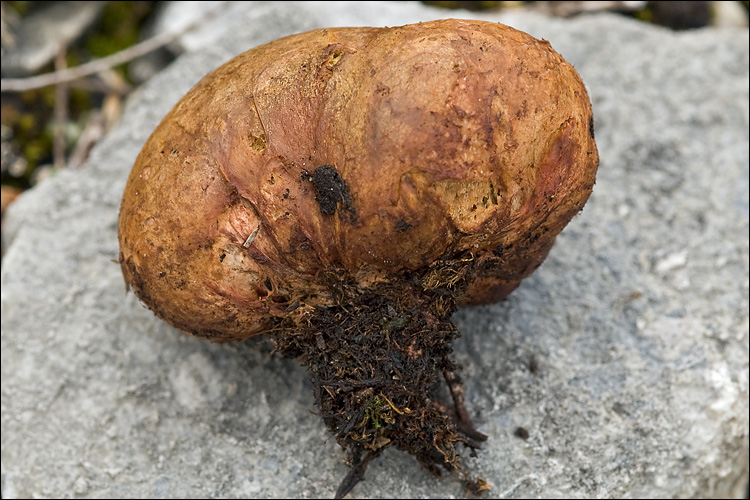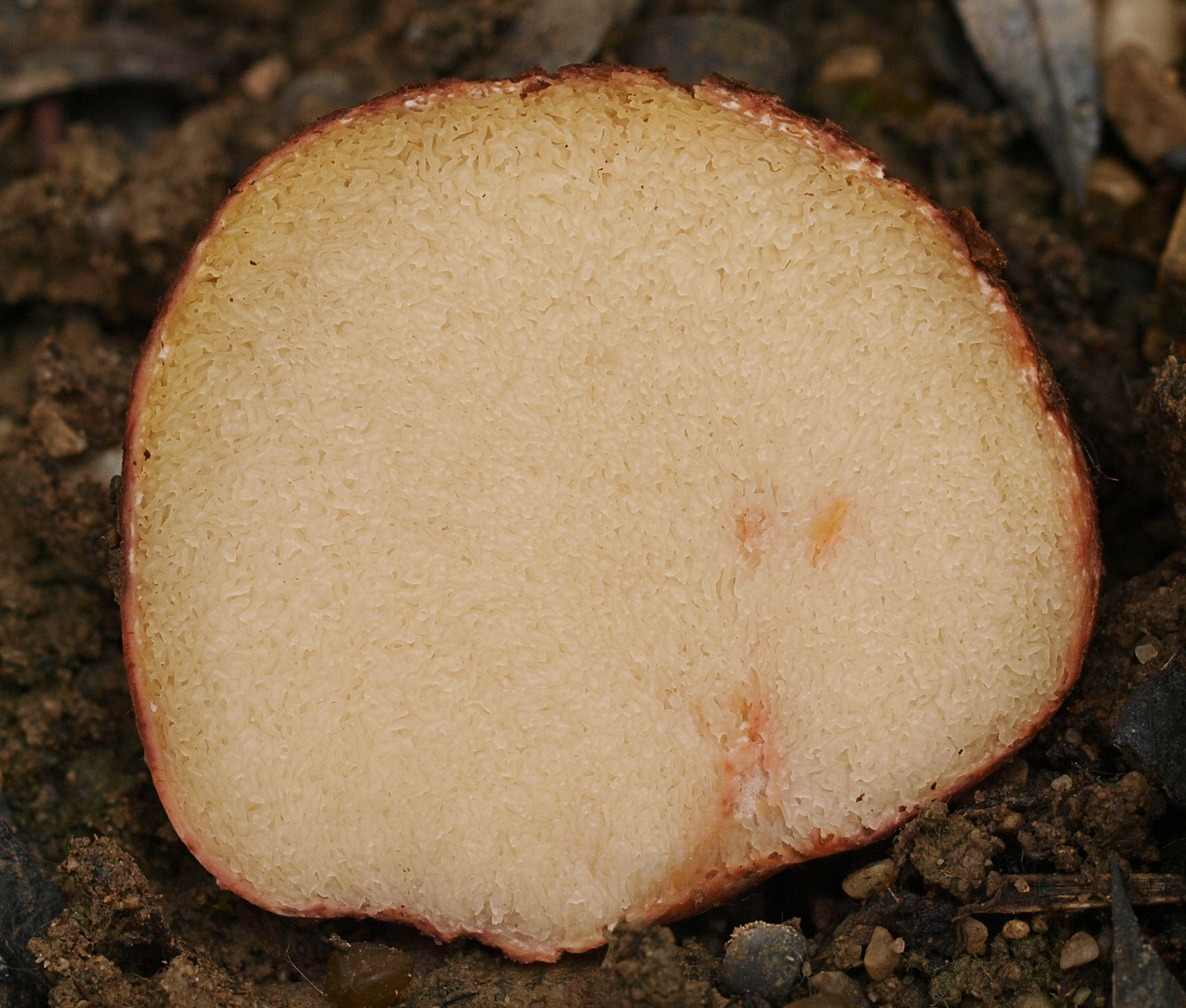알버섯속
"오늘의AI위키"의 AI를 통해 더욱 풍부하고 폭넓은 지식 경험을 누리세요.
1. 개요
알버섯속(Rhizopogon)은 1817년 유럽에서 처음 기술된 곰팡이 속으로, 현재 150종 이상이 알려져 있다. 온대 기후의 북반구 지역에 광범위하게 분포하며, 분자 계통 발생학적 방법을 통해 Rhizopogon, Versicolores, Villosuli, Amylopogon, Roseoli의 5개 아속으로 분류된다. 이들은 소형 포유류와 사슴의 먹이로, 포유류를 통해 포자가 분산된다. 또한 산불이나 벌채 이후 나무 묘목의 뿌리에 나타나며, 일부 종은 솔붓꽃과 같은 식물의 종자 발아를 돕는 효소를 분비하여 침입종을 촉진하기도 한다. 알버섯속은 임업에서 나무 성장을 개선하는 데 사용되기도 하며, 일부 종은 식용으로, 특히 일본에서 진미로 여겨진다.
더 읽어볼만한 페이지
| 알버섯속 - [생물]에 관한 문서 | |
|---|---|
| 알버섯속 | |
 | |
| 학명 | Rhizopogon Fr. (1817) |
| 명명자 | Fr. (1817년) |
| 모식종 | Rhizopogon luteolus |
| 모식종 명명자 | Fr. & Nordholm (1817년) |
| 하위 분류 | |
| 종 | 알버섯 (Rhizopogon rubescens) 본문 참조 |
2. 분류 및 역사

Elias Magnus Fries는 1817년 유럽에서 알버섯속(''Rhizopogon'')을 처음 기술하였다.[2] 북아메리카의 알버섯속에 대한 단행본은 1966년 Alexander H. Smith에 의해 출판되었으며,[3] Sanford Myron Zeller는 이 속 연구에 기여하여 사후 공동 저자로 등재되었다. 유럽의 알버섯속에 대한 단행본도 출판되었다.[4] 최근에는 분자 계통 발생학적 방법이 알버섯속의 분류학적 개념을 수정하는 데 기여하고 있다.[5] 알버섯속은 온대 기후의 북반구 지역에 광범위하게 분포하지만, 종 다양성은 북아메리카와 유럽에서만 잘 알려져 있다. 현재 150종 이상이 알려져 있으며, 자실체의 성숙 과정에 따라 특징이 크게 달라져 단일 곰팡이의 다양한 발달 단계에서 여러 종이 설명되기도 했다.
분자 계통 발생학적 방법을 통해 알버섯속은 5개의 아속으로 분류된다.[5] 이들은 알버섯속 아속(Rhizopogon), 얼룩알버섯 아속(Versicolores), 털알버섯 아속(Villosuli), 전분알버섯 아속(Amylopogon) 그리고 붉은알버섯 아속(Roseoli)이다.
2. 1. 역사적 분류
Elias Magnus Fries는 1817년 유럽에서 알버섯속(''Rhizopogon'')을 처음 기술하였다.[2] 북아메리카의 알버섯속에 대한 단행본은 1966년 Alexander H. Smith에 의해 출판되었으며,[3] Sanford Myron Zeller는 이 속 연구에 기여하여 사후 공동 저자로 등재되었다. 유럽의 알버섯속에 대한 단행본도 출판되었다.[4] 최근에는 분자 계통 발생학적 방법이 알버섯속의 분류학적 개념을 수정하는 데 기여하고 있다.[5] 알버섯속은 온대 기후의 북반구 지역에 광범위하게 분포하지만, 종 다양성은 북아메리카와 유럽에서만 잘 알려져 있다. 현재 150종 이상이 알려져 있으며, 자실체의 성숙 과정에 따라 특징이 크게 달라져 단일 곰팡이의 다양한 발달 단계에서 여러 종이 설명되기도 했다.2. 2. 현대적 분류
분자 계통 발생학적 방법을 통해 알버섯속은 5개의 아속으로 분류된다.[5] 이들은 알버섯속 아속(Rhizopogon), 얼룩알버섯 아속(Versicolores), 털알버섯 아속(Villosuli), 전분알버섯 아속(Amylopogon) 그리고 붉은알버섯 아속(Roseoli)이다.3. 생태

;포유류 먹이 및 포자 분산
''알버섯속'' 종은 북미 서부 지역의 많은 소형 포유류[6][7]뿐만 아니라 사슴[8]의 먹이에서 흔한 구성 요소로 자리 잡았다. ''알버섯속'' 포자의 생존력은 유지되며[9][10] 포유류의 장 통과 후에도 증가할 수 있어,[9] 포유류는 ''알버섯속''의 중요한 분산 매개체가 된다.
;교란 생태
알버섯속(''Rhizopogon'') 종은 묘목이 정착하는 동안 나무의 뿌리에 서식하는 곰팡이 군집의 일반적인 구성원이며, 오래된 임상에도 계속 존재한다.[11][12] 알버섯속 포자는 토양에서 오래 생존하며, 일부 종의 포자는 시간이 지남에 따라 생존력이 증가하면서 최소 4년 동안 생존할 수 있다.[13] 알버섯속은 산불[14]이나 벌채[15]와 같은 교란 이후 나무 묘목의 뿌리에 특히 흔하게 나타나는 것으로 보인다. 알버섯속은 또한 성숙한 나무의 뿌리에서 관찰되지 않은 침엽수림 토양에서 자라는 화분 재배[14][16][17][18] 및 노지 재배[14] 침엽수 묘목의 풍부한 정착자이기도 하다. 이러한 발견은 알버섯속 종이 교란 이후 침엽수림의 회복에 중요한 요소임을 시사한다.
;침입종 촉진
알버섯속의 일부 종에서 분비되는 효소는 노루발속의 일부 종, 예를 들어 솔붓꽃( ''Pterospora andromedeae'')에서 종자 발아를 활성화하는 데 필수적이다.[21] 이는 ''알버섯속''을 ''솔붓꽃''과 같은 종에 필수적인 숙주로 만든다. 또한, 외부 효소 활성은 토양 내 영양분을 분해하는 데 도움을 주어 숙주 종, 주로 소나무속 내에서 더 높은 경쟁 우위를 제공한다.[22][27] 토양 내 ''알버섯속''의 존재는 ''소나무속''을 침입종으로 만드는 데 기여한다.[23] 이 외부 효소 활성은 질소에 의해 제한된다.[22] ''솔붓꽃''이 기생하는 ''아밀로포곤'' 아속의 경우, 외부 효소 생산에 드는 질소 비용은 일부 ''솔붓꽃''이 숙주로 하는 버크홀데리아과 내 세균에 의해 충당된다.[24]
3. 1. 포유류 먹이 및 포자 분산
''알버섯속'' 종은 북미 서부 지역의 많은 소형 포유류[6][7]뿐만 아니라 사슴[8]의 먹이에서 흔한 구성 요소로 자리 잡았다. ''알버섯속'' 포자의 생존력은 유지되며[9][10] 포유류의 장 통과 후에도 증가할 수 있어,[9] 포유류는 ''알버섯속''의 중요한 분산 매개체가 된다.3. 2. 교란 생태
알버섯속(''Rhizopogon'') 종은 묘목이 정착하는 동안 나무의 뿌리에 서식하는 곰팡이 군집의 일반적인 구성원이며, 오래된 임상에도 계속 존재한다.[11][12] 알버섯속 포자는 토양에서 오래 생존하며, 일부 종의 포자는 시간이 지남에 따라 생존력이 증가하면서 최소 4년 동안 생존할 수 있다.[13] 알버섯속은 산불[14]이나 벌채[15]와 같은 교란 이후 나무 묘목의 뿌리에 특히 흔하게 나타나는 것으로 보인다. 알버섯속은 또한 성숙한 나무의 뿌리에서 관찰되지 않은 침엽수림 토양에서 자라는 화분 재배[14][16][17][18] 및 노지 재배[14] 침엽수 묘목의 풍부한 정착자이기도 하다. 이러한 발견은 알버섯속 종이 교란 이후 침엽수림의 회복에 중요한 요소임을 시사한다.3. 3. 침입종 촉진
알버섯속의 일부 종에서 분비되는 효소는 노루발속의 일부 종, 예를 들어 솔붓꽃( ''Pterospora andromedeae'')에서 종자 발아를 활성화하는 데 필수적이다.[21] 이는 ''알버섯속''을 ''솔붓꽃''과 같은 종에 필수적인 숙주로 만든다. 또한, 외부 효소 활성은 토양 내 영양분을 분해하는 데 도움을 주어 숙주 종, 주로 소나무속 내에서 더 높은 경쟁 우위를 제공한다.[22][27] 토양 내 ''알버섯속''의 존재는 ''소나무속''을 침입종으로 만드는 데 기여한다.[23] 이 외부 효소 활성은 질소에 의해 제한된다.[22] ''솔붓꽃''이 기생하는 ''아밀로포곤'' 아속의 경우, 외부 효소 생산에 드는 질소 비용은 일부 ''솔붓꽃''이 숙주로 하는 버크홀데리아과 내 세균에 의해 충당된다.[24]4. 종 목록
- ''Rhizopogon albidus''
- ''Rhizopogon ater''
- ''Rhizopogon brunsii''
- ''Rhizopogon buenoi''
- ''Rhizopogon defectus''
- ''Rhizopogon ellenae''
- ''Rhizopogon ellipsosporus''
- ''Rhizopogon evadens''
- ''Rhizopogon fulvigleba''
- ''Rhizopogon fuscorubens''
- ''Rhizopogon hawkerae''
- ''Rhizopogon himalayensis''
- ''Rhizopogon luteolus''
- ''Rhizopogon maculatus''
- ''Rhizopogon melanogastroides''
- ''Rhizopogon mengei''
- ''Rhizopogon nigrescens''
- ''Rhizopogon occidentalis''
- ''Rhizopogon ochraceorubens''
- ''Rhizopogon parasiticus''
- ''Rhizopogon parksii''
- ''Rhizopogon parvisporus''
- ''Rhizopogon pedicellus''
- ''Rhizopogon pseudovillosulus''
- ''Rhizopogon rocabrunae''
- ''Rhizopogon roseolus''
- ''Rhizopogon rubescens''
- ''Rhizopogon salebrosus''
- ''Rhizopogon semireticulatus''
- ''Rhizopogon subareolatus''
- ''Rhizopogon subaustralis''
- ''Rhizopogon subcaerulescens''
- ''Rhizopogon subgelatinosus''
- ''Rhizopogon subpurpurascens''
- ''Rhizopogon subsalmonius''
- ''Rhizopogon succosus''
- ''Rhizopogon togasawariana''
- ''Rhizopogon truncatus''
- ''Rhizopogon vesiculosus''
- ''Rhizopogon villosulus''
- ''Rhizopogon vinicolor''
- ''Rhizopogon vulgaris''
- ''Rhizopogon atroviolaceus''
- ''Rhizopogon brunneniger''
5. 민속균학
5. 1. 임업
20세기 초, 서호주의 ''Pinus radiata'' 조림지에서 ''Rhizopogon luteolus''를 도입하여 나무의 성장을 개선하는 것이 관찰된 이후, 임업에서 알버섯속 종의 의도적인 사용이 처음으로 이루어졌다.[25] 그 이후, 알버섯속 종은 관리되는 숲의 구성 요소로 널리 연구되었다. 알버섯속 종은 소나무 및 미국원주목 목재 조림지의 나무 뿌리를 식민지화하는 외생균근 군집의 일반적인 구성원으로 알려져 있다.[26] 자연 발생 ''Rhizopogon roseolus'' (''=rubescens'') 포자는 다른 외생균근 곰팡이의 포자와 경쟁하여, 경쟁하는 포자가 묘목에 직접 접종되었을 때에도 소나무 조림지에서 우위를 점하는 것으로 나타났다.[27] 소나무[28] 및 미국원주목[29] 조림 묘목의 생존율과 성과는 알버섯속 종으로 접종한 후에 증가한다.5. 2. 식용
알버섯속은 식용으로 간주되지만, 대부분 요리적 가치는 낮게 평가된다.[30] 예외적으로 ''Rhizopogon roseolus'' (''=rubescens'')는 일본에서 전통적으로 쇼로(쇼로/松露일본어)라는 이름으로 불리며 진미로 여겨진다.[31] 일본과 뉴질랜드의 소나무 재배지에서 이 버섯의 상업적 재배 기술이 개발되어 성공적인 결과를 얻었다.[31]6. 갤러리
참조
[1]
논문
Molecular systematics and biological diversification of Boletales
[2]
서적
Symbolae Gasteromycorum
Ex officina Berlingiana
[3]
논문
A Preliminary Account of the North American Species of ''Rhizopogon''
http://name.umdl.umi[...]
[4]
서적
The Genus ''Rhizopogon'' in Europe
BCG
[5]
논문
Biology of the ectomycorrhizal genus ''Rhizopogon''. VI. Re-examination of infrageneric relationships inferred from phylogenetic analyses of ITS sequences
[6]
논문
Interactions among squirrels, mycorrhizal fungi, and coniferous forests in Oregon
[7]
논문
Hypogeous ectomycorrhizal fungal species on roots and in small mammal diet in a mixed conifer forest
[8]
논문
Ectomycorrhizal ecology under primary succession on coastal sand dunes: interactions involving ''Pinus contorta'', suilloid fungi and deer
[9]
논문
Mycorrhizal effectiveness of ''Rhizopogon'' spores recovered from faecal pellets of small forest-dwelling mammals
[10]
논문
Formations of Ponderosa pine ectomycorrhizae after inoculation with feces of tassel-eared squirrels
[11]
논문
Ectomycorrhizal fungal succession in mixed temperate forests
[12]
서적
Ectomycorrhizal Fungi Key Genera in Profile
Springer Berlin
[13]
논문
Inoculum potential of ''Rhizopogon'' spores increases with time over the first 4 yr of a 99-yr spore burial experiment
[14]
논문
Mycorrhizal colonization of ''Pinus muricata'' from resistant propagules after a stand-replacing wildfire
[15]
논문
The spatial influence of ''Pseudotsuga menziesii'' retention trees on ectomycorrhiza diversity
https://naldc-legacy[...]
[16]
논문
Community structure of ectomycorrhizal fungi in a ''Pinus muricata'' forest: minimal overlap between the mature forest and resistant propagule communities
[17]
논문
''Rhizopogon'' spore bank communities within and among California pine forests
[18]
논문
Revisiting the host effect on ectomycorrhizal fungal communities: implications from host–fungal associations in relict ''Pseudotsuga japonica'' forests
[19]
논문
First record of North American fungus ''Rhizopogon pseudoroseolus'' in Australia and prediction of its occurrence based on climatic niche and symbiotic partner preferences
2019-06-07
[20]
논문
Community structure and functional group of root-associated Fungi of ''Pinus sylvestris'' var. ''mongolica'' across stand ages in the Mu Us Desert
2020-03
[21]
논문
In vitro germination of nonphotosynthetic, myco-heterotrophic plants stimulated by fungi isolated from the adult plants
2000-11-27
[22]
논문
Differences in ectomycorrhizal community assembly between native and exotic pines are reflected in their enzymatic functional capacities
2019-11-16
[23]
논문
Novel interactions between non-native mammals and fungi facilitate establishment of invasive pines
2014-12-15
[24]
논문
Invariant Communities of Endophytic Nitrogen-fixing Bacteria Associated with a Non-photosynthetic Plant.
2019
[25]
논문
Soil organisms. The dependence of certain pine species on a biological soil factor.
[26]
논문
Biology of the ectomycorrhizal genus, ''Rhizopogon'' I. Host associations, host-specificity and pure culture syntheses
[27]
논문
Dominance of the mycorrhizal fungus ''Rhizopogon rubescens'' in a plantation of ''Pinus pinea'' seedlings inoculated with ''Suillus collinitus''
[28]
논문
Survival of Ponderosa pine (''Pinus ponderosa'' Dougl. ex Laws) seedlings outplanted with ''Rhizopogon'' mycorrhizae inoculated with spores at the nursery
[29]
논문
Ectomycorrhizal formation and plantation performance of Douglas-fir nursery stock inoculated with ''Rhizopogon'' spores
[30]
서적
Field guide to North American Truffles
Ten Speed Press
[31]
논문
Edible ectomycorrhizal mushrooms: challenges and achievements
[32]
웹사이트
Rhizopogon Fr. 1817 - Wurzeltrüffel, Wurzelbart
http://www.trueffel-[...]
[33]
논문
Molecular systematics and biological diversification of Boletales
본 사이트는 AI가 위키백과와 뉴스 기사,정부 간행물,학술 논문등을 바탕으로 정보를 가공하여 제공하는 백과사전형 서비스입니다.
모든 문서는 AI에 의해 자동 생성되며, CC BY-SA 4.0 라이선스에 따라 이용할 수 있습니다.
하지만, 위키백과나 뉴스 기사 자체에 오류, 부정확한 정보, 또는 가짜 뉴스가 포함될 수 있으며, AI는 이러한 내용을 완벽하게 걸러내지 못할 수 있습니다.
따라서 제공되는 정보에 일부 오류나 편향이 있을 수 있으므로, 중요한 정보는 반드시 다른 출처를 통해 교차 검증하시기 바랍니다.
문의하기 : help@durumis.com